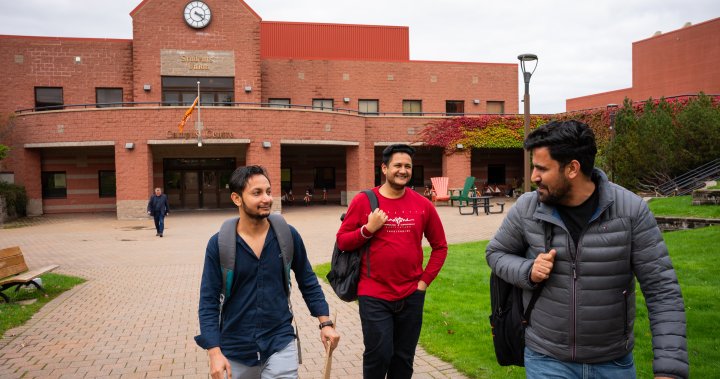Faced with scrutiny over issues of housing and affordability, the federal government resorted to a measure it once said would be a last resort. On Monday, Ottawa announced a cap on the number of international students coming into the country.
The government’s line was clear. Many communities in the country were taking in temporary residents beyond their capacity.
“We do see that there’s certain pockets of the country that have seen significant increase in population growth as a result of institutions taking on more students than they can handle,” Housing Minister Sean Fraser, who previously held the immigration portfolio, told reporters on Monday.
The government’s other recent measures, such as increasing the financial requirements to apply for a study permit, were not enough.
Fraser said the situation necessitated a cap. “It seems that things have, from that time until now, continued to see growth beyond what certain communities could handle. And that’s what justified the decision to use this particular suite of measures.”
Immigration Minister Marc Miller, who announced the cap, said for 2024 the cap is expected to result in approximately 364,000 approved study permits – a decrease of 35 per cent from 2023.
But some experts believe the cap on international students is largely a matter of optics, a move that would show that the government was “doing something”.
‘TEMPORARILY DAMPENING DEMAND’
Carolyn Whitzman, a housing policy expert and expert advisor to the Housing Assessment Resource Tools project, calls the cuts “largely performative.”
“It says we’re doing something, but it doesn’t address any of the underlying causes, which include (the government having) no idea of how many students are coming in, what kind of housing they need and at what cost.”
Whitzman said the lack of rental and student housing affects not just international students, but domestic students too. She said the cap will not have a major impact on vacancy rates or rent.
“I think this demand side stuff is nonsense. And surely at this point, we recognize that there’s just this critical housing shortage. Trying to temporarily dampen demand through choosing this particular scapegoat (international students) isn’t really going to solve the supply shortage, which has gotten worse over the last year,” she said.
While announcing the student cap on Monday, Miller said the cap would only be in effect for two years. Both Miller and his predecessor Fraser have said that without more immigration, Canada won’t have the workers it needs to build more homes.
Get the latest National news.
Sent to your email, every day.
“We’re soon going to hit a bottleneck with the productive capacity of the Canadian workforce to build the homes we need,” Fraser said on Monday.
Meanwhile, economists have noted that the large influx of newcomers to Canada has taken a toll.
“What’s happened in the Canadian economy over the last year is we had a particularly big surge in population growth through immigration,” Carolyn Rogers, senior deputy governor of the Bank of Canada, told reporters on Wednesday. “It came at a time when there was constrained supply. You can see this very clearly, most clearly, really in the housing sector and in particular in rents.”

Migrant Students United, the student wing of Migrant Workers Alliance for Change (MWAC), said immigrants in general, and migrant students in particular, were being scapegoated to distract from those who are actually responsible.
“We know that there are people who own multiple units that are sitting empty in the middle of a housing crisis,” Sarom Rho, an organizer with MWAC, told Global News.
She said the logic that immigrants have been driving up housing prices is not sound.
“We’ve seen that even when people were not able to come to the country on work or study permits (during the lockdowns of 2020 and 2021) housing prices continued to rise,” she said.
Whitzman said the notion that “teeming masses are going to break down the doors” was rooted in racist fears around immigration. She said Canada has a history of different actors calling for a crackdown on immigration when the housing market gets tough.
“If you look at the early 20th century in Toronto, there were a lot of affordability issues. There weren’t that many indoor toilets, there was a lot of overcrowding. There were a lot of the problems that we see today in terms of overcrowding and affordability. And the medical officer of health did a slum report where he said the main problem is these foreign people whose notions of cleanliness are not (the same as) ours. That kind of rhetoric has been around for a long time,” she said.
MEASURING CORE HOUSING NEED
Whitzman said the big flaw in Canadian housing policy is that it does not count large swathes of people when it comes to measuring something called core housing need.
Canada uses core housing need, introduced in 1991, as a metric to ascertain how many people in the country are in need of housing. Whitzman said the government’s method of calculating core housing need is flawed.
“It doesn’t include homeless people. It doesn’t include anyone who’s in a collective dwelling, which includes group homes or people in long-term care or people in rooming houses. If you don’t have a separate entrance, bathroom and kitchen, you aren’t counted for housing need,” she said.
She said students, who are considered to be in a “temporary and voluntary” state of homelessness, are not counted either. Therefore, there is no national housing policy specifically geared towards addressing the needs of students.
This has led to exclusionary zoning laws and a severe lack of purpose-built rental and student housing. In most parts of Canada, students both international and domestic are left to the mercy of landlords in single-family homes.
Rho said there are horror stories of 10-12 students living in basements in crowded, unsafe conditions.
“The crisis is simply the fact that people are coming into the country and are denied basic rights and protections.”
In November, a report by the Office of the Federal Housing Advocate (OFHA) said that Canada is short 4.4 million affordable homes – three million more than what the Canada Mortgage Housing Corporation (CMHC) estimates.
LOOK TO THE PAST TO BUILD FOR THE FUTURE
Last month, Housing Minister Sean Fraser announced that the federal government was looking to a post-war housing strategy to build housing for the future. This includes a catalogue of pre-approved designs that builders could use to rapidly build more affordable housing.
Whitzman said the Canadian government can do the same for student housing, seeing as Canada once had a vibrant student housing market.
“In the 60s and 70s, there was large-scale development of student housing that was non-market student housing. (This included) everything from co-ops to student housing to public housing,” she said.
She said provinces and municipalities also need to share the burden, by implementing rent control, funding student housing and ending exclusionary zoning. However, she said, “I think the buck stops at the federal government.”




